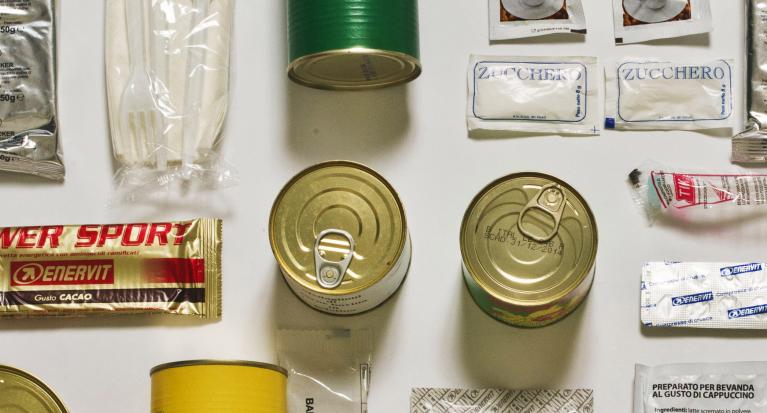Eating in space
Food as a literally unworldly experience.
In 2007, billionaire and former Microsoft executive Charles Simonyi sat down to a meal of quail roasted in Madiran wine, accompanied by chicken Parmentier and apple fondant. The menu had been selected by Simonyi’s friend Martha Stewart and prepared by Michelin-starred chef Alain Ducasse. This sounds quite ordinary, perhaps even slightly pedestrian, for a billionaire, except that this meal was enjoyed aboard the International Space Station (ISS) when Simonyi become the fifth privately-funded astronaut to board it.
Simonyi’s meal stands in stark contrast to our typical conception of astronaut food as rehydrated plastic pouches of chicken stew and pureed peas. It also highlights the shift in space travel from heroic, nationalistic endeavour towards a private pursuit of pleasure. The celebrity endorsements and haute cuisine menus are the latest manifestation of the symbolic value that even something as minor as a plate of food takes on in space travel.
Food and the rituals around it mix the cultural and material in equal proportion, the symbolic and real importance of it magnified in space by the strange weightless environment and cramped living quarters. Space food has always had a large place in the public imagination, because it provides a very familiar, human-sized window into a literally unworldly experience. Looking back at the evolution of space food, especially at its design and role in the daily life of astronauts, nicely encapsulates the changing cultural role of space travel through its history.
First meals in space and early luxuries
In the beginning, the question was as fundamental as “Can we eat in space?” Nobody knew if the human digestive system would be able to operate in microgravity, or even if the astronauts would be able to swallow their food to find out. John Glenn, in addition to being the first American to orbit the earth, became the first man to answer this question by eating beef puree and applesauce out of a toothpaste-like tube as he passed over Nigeria. History does not record how enjoyable he found the meal.
As people began going to space more frequently and for longer periods, food systems evolved to address the attendant nutritional and social issues of extended stays in space. The zenith of space food sophistication came with the Skylab programme of the 1970s.
Pictures from Skylab are full of idealism: crews of bearded men all wearing a uniform of sorts pose with a very deliberate Kubrick-esque coolness. They are clearly presented as heroes on a mission, members of a highly skilled team that combine physical fitness with intellectual chops. The interior is all high modernism: isometric grids, modular storage, sleek brushed stainless and aluminium surfaces. Things line up in neat rows, everything has its place and there is a deliberate differentiation of spaces with small, human-scaled areas for the crew feeding off a large central hall.
With all this space, they were able to pay special attention to the food and dining experience. Skylab remains to this day the only spacecraft to have had refrigeration, so they were able to store fresh foods for longer and in greater variety. To prepare and serve their meals, they had a special warming tray, where every item in the meal mounted into its own specially shaped pocket. The whole tray then attached to this sweet modular table that the astronauts would all sit around and eat together, with a porthole through which they could look back at Earth while they ate.
Food systems and national stereotypes
With the retirement of the Skylab programme and the reduced budget of the 1980s, the design of food systems took a decisive turn from the heroic to the austerely practical. Gone were the communal dining areas and customised preparation tools, replaced with the universal plastic retort pouch, with a handy barcode to identify the contents and Velcro tab to allow astronauts to anchor it willy-nilly wherever they happened to be eating.
The food itself is only partially developed by NASA now, with much of it simply being repackaged commercial food (M&Ms in particular have had excellent free advertising in space). Without refrigeration, everything has to be shelf-stable at room temperature which means it has to be freeze-dried or thermostabilised, with all the textural limitations this implies. The cooking, such as it is, is now done either using an automated water dispenser built into the wall of the station, or a decidedly Rube Goldberg-esque heated suitcase Velcroed to the wall. Particularly poignant are the condiments, which are the exact same small plastic packets found in fast-food takeaway bags around the world and sent up bunched in a plastic bag in a way that is strongly reminiscent of the hoarded ketchup stashes found in the cars of many Americans.
Or rather, this is where the American system has ended up. Since the retirement of the Space Shuttle, the only place currently left to eat in space is the International Space Station, which boasts a delightful range of national stereotypes embodied through food. We have, of course, the American system of pragmatic commercial food supplying half the food to the station. The other half is supplied by the Russians and fits with the rugged “don’t fix it if it isn’t broken” image of their space programme. Rather than plastic bags, the food almost all comes in cans or tubes. Instead of there being mostly commercial products off of supermarket shelves, there are delicacies like smoked fish and cheese curds with nuts, cooked by dedicated grandmotherly types. Rather than heating the food with hot water as they stand in front of a wall, they have a substantial dining table where everyone can sit and reheat their food in slots built into the table.
To add the perfect finishing touch to this continuation of cold-war national stereotypes in space, there are the French. Alain Ducasse did not merely create the meal Charles Simonyi took into orbit; he also works with the French space agency to provide “special event meals”, or as Ducasse himself describes them, “food for extreme pleasure” as only the French could provide.
There are apocryphal stories of cultural tensions on the ISS, for example, the tension that arose during the initial joining of the Russian and American modules over whether to eat together, Russian-style, or casually snack as needed, American-style. According to the stories, the cosmonauts were so offended by the Americans’ lack of social graces they built an ersatz dining table big enough for everyone and launched a formal protest to insist that everyone on the station share at least one meal a day. While there is no definitive statement as to how this turned out, or even how true it is, judging from the hundreds of photographs of all the ISS inhabitants enjoying a meal on the Russian side, it seems that detente has been achieved.
There are no recorded complaints about Alain Ducasse’s meals.
Credits
PostlerFerguson
PostlerFerguson is a London-based design consultancy that works across the entire product ecosystem, from branding and packaging to digital and production.
Founded in 2007 by Martin Postler and Ian Ferguson, their clients include Nude Audio(HK), Me&City (CN), Victoria & Albert Museum (UK), the British Council (UK), Goods of Desire (HK), Puzhen Life Corporation (HK), Loewe (CN), and the Massachusetts Institute of Technology (USA). They have also been nominated for London’s Design Museum’s Designs of the Year award in 2012 and won the EU-sponsored Nanopinion project in 2013.
Martin and Ian also run Platform 17 in the Royal College of Art’s Design Products Programme, which engages in research into the future of consumer electronics.
Their 2013 exhibition “Personal Space” at the Massachusetts Institute of Technology presented designs for cooking and living in the private space stations of the future.
DOSSIER Optimising Nutrition |
| Fortifying staple foodstuffs | |
| Targeted nutrition and sport | |
| War meals | |
| Brief History of Eating in space | |
| All dossiers | |
Floating food - Cooking and eating in orbit
Weightlessness presents compelling but counter-intuitive challenges to the preparation and consumption of food. The most mundane experiences become extraordinary.
When you wash your hands, surface tension pulls the water across your skin like a gently jiggling transparent coating. Your...


